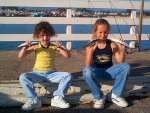Sardine. There was a time when the commercial fishery for Pacific sardines, Sardinops caerulea, was the largest fishery in North America. Boats in California in the ‘30s and ‘40s, saw peak catches of as much as 700,000 metric tons. Monterey was the center of action, although the fishery extended south to Los Angeles, and the canneries in Monterey (on Cannery Row) and in Los Angeles (Fish Harbor on Terminal Island) ran what seemed like non-stop shifts processing the fish (and disturbing neighbors by their smell). Then, by the late ‘40s, the fish began to disappear and in a few years most of the canneries had closed (although those in Los Angeles could switch to tuna). Eventually, in 1967, a moratorium shut down the commercial fishing for sardines. The fish had been the victim of bad science, poor management by the Department of Fish and Game, and over fishing.

The water temperatures had dropped and when that happened the fish had a problem. We now know sardines and anchovies go up and down in cycles corresponding to water temperatures. When water temperatures increase the number of sardines goes up and the number of anchovies goes down. When water temperatures decrease the number of anchovies goes up but the number of sardines goes down. Unfortunately when the water temperatures went down in the late ‘40s, and the number of sardines started to decrease, the sardine boats and their big nets just kept hauling in the sardines—in unsustainable numbers. The Fish and Game Department was worried but didn't limit the catch. Eventually there were no sardines, or at least very few sardine to be found.
However, the stock eventually began to rebound by the ‘90s and a new commercial fishery developed, one that thrived into the 2000s. However, by 2006, there seemed to be a new slide in numbers and eventually, in 2015, the fishery was closed once again. Today the sardines are still showing up, and available to pier anglers, but not in the numbers seen in the ‘90s.
I knew little about sardines when I began to pier fish back in the early ‘60s, but both their absence and rebound is reflected in my records. I never caught a single sardine at a California pier from 1962 until 1990 (hundreds of trips) when I finally landed a few at the Seal Beach Pier and Belmont Veterans Pier in Long Beach. I soon began to catch them at many piers and by 1994 had experienced some really phenomenal fishing at several piers (especially those in the Morro Bay area). Given the large-sized schools (called shoals), some as large as 10 million fish but usually under a million, if you catch one fish you are probably destined to catch more. Today I have caught them at 28 piers ranging from the Imperial Beach Pier near the Mexican border to Citizen’s Dock in Crescent City, just over 20 miles from the Oregon border. Their numbers still go up some years and down others but I seem to catch a few each year.
They are, of course, one of the best baits both as fresh, frozen or live bait. And, since the ‘90s, they have generally been available in bait shops (although some now report shortages).
Sardines as bait are tougher than mackerel and don’t soften as quickly when set out. They may be the best striper bait but may not be quite as good as mackerel if you’re looking for a strong smelling, oily bait (as for sharks). Nevertheless, they are a top bait and should be used when anchovies and mackerel are unavailable. Of note, at the first Pier Fishing in California Mud Marlin (bat ray) Derby held at the Berkeley Pier, a combination bait of a sardine placed inside the body of a squid proved to be the best bait. A whole sardine can sometimes be used if you’re seeking out striped bass but strip bait should be used when seeking the smaller species.
Sometimes people mistake them for herring but ridges running downward on the gill cover, and a series of black spots on the back, distinguish them from their close relatives.

